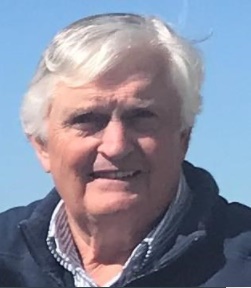In Remembrance: Bruce Greene - 1946-2022
by Nick Bellantoni
reprinted from the Spring, 2022 edition of the FOSA Newsletter
It was in the mid-1980s, before I became the Connecticut State Archaeologist, and while I was assisting the
Albert Morgan Archaeological Society in the excavation of the Morgan Site, probably the largest Native
American village in the state 1,000 years ago on the floodplain of the Connecticut River in Rocky Hill, when I
met Bruce Greene. The site's co-field director, Dave Cooke, a longtime friend of Bruce's, showed me field
notes documenting the excavations being conducted, including a detailed drawing of a large storage feature
with recovered artifacts precisely measured and mapped. I was very impressed with the documentation and
congratulated Dave on the detail of the figures. He shook his head, "I didn't do this," and then pointed to a
fellow sitting on an upside down 5-gallon plastic bucket, writing on a wooden clipboard, said, "He did. He's
an engineer at Pratt." So, I suppose we can say that I was very much impressed with Bruce Greene's fieldwork
before I ever formally met him!
 Bruce was a founding member of the Friends of the Office of State Archaeology, Inc., (FOSA) which was
conceived by his dear friend, June Cooke in the late 1990s. He was one of a small group of avocational and
professional archaeologists that spearheaded the development of the FOSA organization; serving on the
nonprofit's initial board of directors and volunteering in the field when his work at Pratt Whitney allowed.
Bruce was a founding member of the Friends of the Office of State Archaeology, Inc., (FOSA) which was
conceived by his dear friend, June Cooke in the late 1990s. He was one of a small group of avocational and
professional archaeologists that spearheaded the development of the FOSA organization; serving on the
nonprofit's initial board of directors and volunteering in the field when his work at Pratt Whitney allowed.
He was a decades long member of the Archaeological Society of Connecticut and contributed articles to the
Society's annual Bulletin. He was a longtime supporter of the Institute for American Indian Studies in
Washington Depot, Connecticut, where he donated his grandfather's Indian artifact assemblage - the George O.
Murphy Collection is now housed and utilized by researchers studying New England prehistory.
Bruce was born in 1946 in Westerly, RI, and came of age in Stonington, CT, where he excelled as a star track
and football player in high school. So good was he as an athlete that he received numerous scholarships to
play football from many Ivy League schools, including Cornell, Wesleyan, Trinity, Princeton, and Dartmouth
Colleges among others. He chose to play football and matriculate at Trinity College in Hartford as an engineering student. He graduated with a BA in 1968 and found employment with Pratt & Whitney Aircraft Corporation as an aeronautical engineer working there for 35 years. Later in life, following his passion for history, Bruce Greene returned to Trinity for two Master's Degrees in American Studies with a specialization in
archaeological resources. His second master's thesis at Trinity was on the Patchaug Hoax Site in eastern
Connecticut.
After the death of Dave Cooke and his own retirement from Pratt & Whitney, Bruce assisted me as the Office
of State Archaeology's field director. He supervised University of Connecticut students and FOSA volunteers
in archaeological field methods; was responsible for our office record cataloguing and laboratory management;
and, he did this as a volunteer, devoting countless hours and his expertise to our office and preservation
efforts. His work was meticulous, detailed, accurate, and, I am sure, the overall product of his engineering
training that he ably adapted to the science of archaeology. We are forever indebted.
Through all this, Bruce developed an expertise in the material culture of Native and Colonial Americans. He
aided the Connecticut State Museum of Natural History and the Connecticut Historical Society in identifying
artifacts from their Indian and historical collections. He also assisted in cataloguing and developing computer
databases for their museum records and promoted his skills as an archaeological consultant offering services
to other institutions with archaeological collections. This was no small achievement.
That is simply a description of his many roles in Connecticut archaeology and the skills Bruce brought to his
work. It does not reference the personal attributes he endeared while doing so. Students and FOSA volunteers
remember him as a very caring, patient and intelligent man, who taught them archaeological techniques.
While Bruce could be very serious in the field about doing things correctly, he tempered that determination
with humor and enthusiasm. He never lost the "thrill of discovery," the importance of recording and the
significance of cultural interpretation that is essential to the archaeological process. He was able to
communicate his passion with a dedicated group of men and women who shared a strong love of history and
archaeology that cemented longstanding friendships.
And, I think that is what I will remember and cherish the most about Bruce: our friendship! We had a lot
of adventures and laughs together. Long days filled with hard fieldwork, excitement and animated discussions
while eating lunches sitting on the ground, backs leaning against large tree trunks. Drives through the
Connecticut countryside going to and coming from an archaeological site filled with stories of discovery,
family, friends and the relevance of our work together. Bonds strengthened by mutual appreciation and respect,
developing into friendships that have persisted for decades. We will miss him dearly.
Readers are invited to add their thoughts.
Please send an email to fosa.ct@gmail.com, using "FOSA Website: Remembrance" in the subject line.